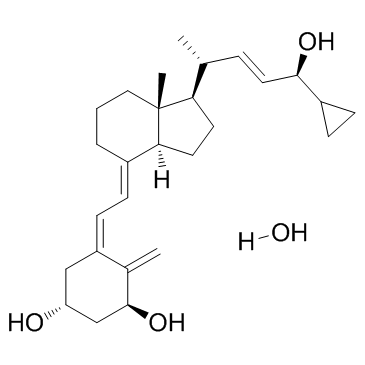Calcipotriol (monohydrate)
Modify Date: 2024-01-07 23:23:31

Calcipotriol (monohydrate) structure
|
Common Name | Calcipotriol (monohydrate) | ||
|---|---|---|---|---|
| CAS Number | 147657-22-5 | Molecular Weight | 430.62000 | |
| Density | N/A | Boiling Point | N/A | |
| Molecular Formula | C27H42O4 | Melting Point | N/A | |
| MSDS | N/A | Flash Point | N/A | |
Use of Calcipotriol (monohydrate)Calcipotriol monohydrate is a synthetic VitD3 analogue with a high affinity for the vitamin D receptor. |
| Name | calcipotriol monohydrate |
|---|---|
| Synonym | More Synonyms |
| Description | Calcipotriol monohydrate is a synthetic VitD3 analogue with a high affinity for the vitamin D receptor. |
|---|---|
| Related Catalog | |
| Target |
vitamin D receptor[1] |
| In Vitro | When NHEK cells are not stimulated with IL-17A or IL-22, Calcipotriol slightly enhances (0.2 nM) IL-8 mRNA expression or has no effect (2-20 nM). The addition of IL-17A and IL-22 markedly increased the mRNA expression of IL-8, confirming our previous study. This enhanced IL-8 mRNA expression is suppressed by Calcipotriol at 2, 20 and 40 nM in a dose dependent manner[1]. Treatment of natural killer (NK) cells with drugs modulates their expression of NK cytotoxicity receptors or KIR. Human NK cells are pre-treated with 100, 10 or 1 ng/mL of 1,25(OH)2D3, Calcipotriol or FTY720 for 4 h. All three concentrations of 1,25(OH)2D3, Calcipotriol and FTY720 significantly up-regulate the expression of NKp30 on the surface of NK cells after 4 h incubation[2]. |
| In Vivo | One out of the 32 animals in each of the groups has died, except for the Diclofenac plus DFMO plus Calcipotriol group, where all animals survived. Survival is equally distributed between the groups. The weight gain is significantly smaller in the groups treated with Diclofenac plus Calcipotriol (p=0.018) and Diclofenac plus DFMO plus Calcipotriol (p=0.002) compare with placebo (linear regression model)[3]. |
| Cell Assay | Normal human epidermal keratinocytes (NHEK) are grown in serum-free keratinocyte growth medium Epilife and used at third passage in all experiments. Growth supplement is omitted 48 h before experiments. As a control, IL-17A and IL-22 are either added or not added to the cells. Cultured NHEK cells are stimulated with IL-17A (200 ng/mL) and/or IL-22 (200 ng/mL) followed by co-incubation in the presence or absence of Calcipotriol at 0.2-40 nM to test its modulatory effect. Cells are harvested 3 days later and subjected to real-time quantitative PCR (qPCR). Culture supernatants are also collected and frozen at -80°C until use for ELISA[1]. |
| Animal Admin | Mice[3] The 160 female SKH-1 hairless mice (6-7 weeks of age) are used. After UV treatment, mice without tumors are randomly divided into five groups, four chemoprevention groups (Diclofenac plus DFMO; Diclofenac plus Calcipotriol; DFMO plus calcitriol; and Diclofenac plus DFMO plus Calcipotriol) and one placebo group (skin lotion). The placebo group used in this study is the same as the one used in an earlier study. The mice are treated with test mixtures once a day, five days a week, for a total of 17 weeks. The test mixtures are applied topically on the dorsal surface of the mice. Ten microliters are applied by a pipette after which the mixture is rubbed onto the skin. This corresponded to the following doses of each active substance in the treatments: 100 μg/week for Diclofenac (30 mg/g undiluted), 0.166 μg/week for Calcitriol (50 μg/g undiluted), and 463.3 μg/week for difluoromethylornithine (DFMO) (139 mg/g undiluted). |
| References |
| Molecular Formula | C27H42O4 |
|---|---|
| Molecular Weight | 430.62000 |
| Exact Mass | 430.30800 |
| PSA | 69.92000 |
| LogP | 5.02630 |
| Storage condition | 2-8℃ |
| Water Solubility | Practically insoluble in water, freely soluble in ethanol (96 per cent), slightly soluble in methylene chloride. |
| Calcipotriol (monohydrate) |
| (1R,3S,5Z)-5-[(2E)-2-[(1R,3aS,7aR)-1-[(1R,2E,4S)-4-cyclopropyl-4-hydroxy-1-methyl-2-buten-1-yl]octahydro-7a-methyl-4H-inden-4-ylidene]ethylidene]-4-methylene-1,3-Cyclohexanediol hydrate |
| Calcipotriol monohydrate |